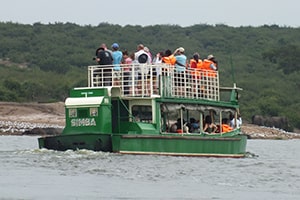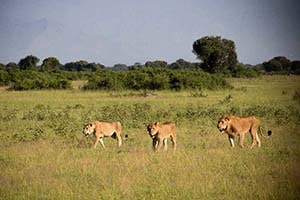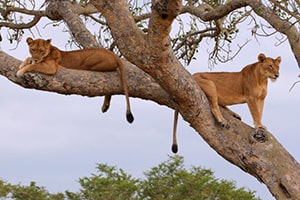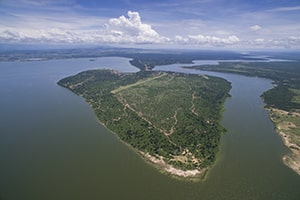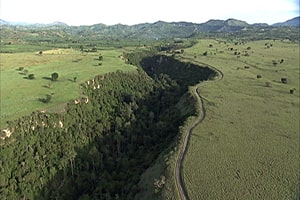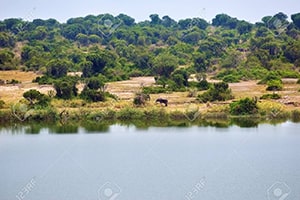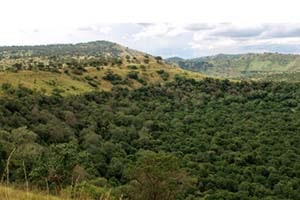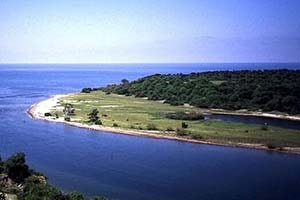Queen Elizabeth National Park Uganda
Queen Elizabeth National Park is a game reserve and one of the tourist attractions in western Uganda. The park is characterised by Wildlife Safari Activities, Accommodations, The Kazinga Channel Boat Cruise, When to Visit its and how to Access the park.
Queen Elizabeth National Park is Uganda’s most popular game reserve for anyone with a keen interest in safaris, beautiful nature and scenic view. The park established in 1954 was named after Queen Elizabeth II. Geographically, the park runs from the foothills of the Rwenzori crater in the north to the shores of Lake Edward to the remote Ishasha River in the south, Lake George and Kazinga Channel, combining a wide variety of habitats like savanna, wetlands and lowland forests among others.
Queen Elizabeth National Park is known for its wildlife like hippopotamuses, elephants, leopards, lions and chimpanzees among the many. It is now home to over 95 species of mammal and over 600 species of birds. The park is known for its volcanic features, comprising volcanic cones and deep craters, many with crater lakes such as Lake Katwe where salt is mined.
Brief about Queen Elizabeth National Park
- It’s found in Kasese, Bushenyi and Rukungiri district.
- Size: 1978 km sq.
- Over 600 bird species.
- Best time for tour: December – February.
- ideal time for the tour: 2-3 days
- Altitude Range: 900 metres on Lake Edward to 1845 metres above sea level at the top of Escarpment of the Western Rift Valley.
- Habitat: Medium altitude moist semi-deciduous forest, moist thicket, riparian forest, riverine bush land, open woodland, open grassland, seasonal and permanent swamps, lakes and rivers.
The Key Species in Queen Elizabeth National Park
African Mourning Dove, Grey-headed Kingfisher, Swamp Fly-catcher, Grey-capped Warbler, The beautiful Black-headed Gonolek, Collard Pranticles, Pin-tailed Whyda Martial Eagle, Gabon and Slender-tailed Night-jars, Great and Long-tailed Cormorants, Black-rumped Buttonquail, Common Squaco Heron, Shoe bill Stork, African Open-billed Stork, African Fish Eagle, African Jacana, Malachite and Pied Kingfishers, African Skimmer, Verreaux’s Eagle-Owl, Black Bee-eater, White-tailed Lark, White-winged Warbler, Papyrus Gonolek, Papyrus Canary, Great white and Pink-backed Pelicans, White-winged Terns.
Things to do Queen Elizabeth National Park
- Game drive safaris
- Boat Cruise on Kazinga Channel
- Forest Walk in Maramagambo
- Chimp Trekking in Kyambura Gorge
- Night Game Drive
- Mangoose Tracking in Mweya Peninsula
- Lion Research tracking
- A Visit to Lake Katwe Salt works
- Ishasha Sector game drive
- Community Tours
- Chimpanzee Tracking in Kalinzu Forest
Birding in Queen Elizabeth National Park
The main camp at Mweya is attractively positioned with finest views of the Rwenzori Mountains. A number of widespread bush species may be seen in the vicinity of the airstrip watch for African Mourning Dove, Grey-headed Kingfisher, Swamp Fly-catcher, Grey-capped Warbler, The Beautiful Black-headed Gonolek, Red-chested sun bird, Slender-billed, Yellow-backed and Lesser Masked Weavers, Pin-tailed Whydah and brimstone Canary, Gabon and Slender-tailed Nightjars, are fairly common along the airstrip.
The Kazinga channel is a magnet for water birds a launch cruise reveals species such as; Great-white and Pink-backed Pelicans, Great and Long-tailed Cormorants, Common Squaco Heron, African open-billed Strok, White-faced Whistling and Knob-billed Ducks, African Fish Eagle, Black Crake, African Jacana, Water Thick-knee, Spur-winged and African Wattled Plovers, Malachite and Pied kingfishers, Swamp flycatchers and Yellow backed Weavers are all common and conspicuous. Numbers of migrants peak in February and March and are nothing short of spectacular with hundreds of thousands of White-winged Terns hovering over the water, millions of common sand Martins and Yellow -wagtails roosting in reed-beds and lesser numbers of palaeartic waders such as the Ringed Plover, Little Stint, Curlew Sandpipers, Common Snipe, Black-tailed Godwit, Marsh, common and Wood sandpipers, Spotted Redshank and common Greenshank feeding along the marshy fringes. A number of national rarities have been recorded from the hippo wallows along the channel including Eurasian Wigeon, Common Teal, Northern Pochard, Mongolian Plover and Jack Snipe. Hundreds of African Skimmers may be seen roosting on sandbars near the entrance to Lake Edward but are migrants from southern tropics and usually present only from December to May. The Kazinga channel may also be viewed from the Katunguru Bridge on the main Mbarara-Kasese road where Pelicans, Terns, Greater Swamp and winged Warblers, Winding and Carruther’s Cisticolas and Papyrus Gonolek may be seen.
Access to the park
Queen Elizabeth National Park is situated about 5-6 hours on the road from Kampala going through Mbarara, Bushenyi and can also be reached from Bwindi. Its accessible by public or private transport. The Main Camp and Park HQ at Mweya is a convenient base for exploring the sites in the northern part of the park, whilst the road network running from Ishasha Camp and Ranger Post, 80 km to the south, provides access to the Ishasha area.
Safari Lodges
- Mweya Safari Lodge – this 5-star luxury lodge ideal for relaxation, it has swimming facilities and different bird species can be seen around the area.
- Simba Safari Camp – this newly built safari accommodation on the border of the national park and only 2 km from the Equator is on a hill and offers spectacular views of Lake George, the Kazinga Channel and the Savannah plains.
- Jacana Safari Lodge – this luxury lodge on the banks of a crater lake is good for relaxation and refreshment for utmost comfort.
- The Institute of Ecology – this is a basic hostel accommodation style.
- Camping – can be done at Mweya, Maramagambo Forest and Ishasha sector. Better to move along camping with facilities.
- Kyambura Safari Lodge
- Katara Lodge
- Ihamba Safari Lodge
- Enganzi Lodge
- Kazinga Channel View Resort
- Pumba Safari Lodge
- Kasenyi Safari Camp
- Kasenyi Wild Game Lodge
Tourist Attractions in Queen Elizabeth National Park
Kyambura Gorge (Kyambura Game Reserves), Mweya Peninsular, Ishasha Sector, Kasenyi Plains (an open Savannah for game drives), Kazinga Channel and Maramagambo Forest among others.
Kazinga Channel
This is a 40 Kilometre water stretch in Queen Elizabeth National Park. A Boat cruise on this channel will show you lots of animals and birds along the shorelines.
Kasenyi Plain
These savannah plains in the park are where most of the game drive safaris take place. During the search for animals from a safari vehicle, you will see lots animals like the bigger cats.
Ishasha Sector
This place in the south of the park is famous for the Tree Climbing lions that hang on the fig trees. And a game drive across the sector is outstandingly amazing.
Mweya Peninsula
This area found between the southern side of Kazinga Channel and Lake Edward offers wonderful water views especially when one is at Mweya Safari Lodge.
Kyambura Gorge
This gorge in the north of Queen Elizabeth National Park is a home to chimpanzees, several primate species, birds and insects visible in shaded forest.
Lake George
Lake George also called Lake Dweru is a lake in Uganda and among the Great Lakes system in Africa. The lake drains to the southwest into Lake Edward via Kazinga Channel.
Maramagambo Forest
Found in Bushenyi district, the forest is part of Queen Elizabeth National Park. The forest reserve is known for bat caves, python, birds and primates.
Lake Edward
Also called Rutanzige is the tinnest of the African Great Lakes. It is found in the Albertine Rift between Uganda and the Democratic Republic of the Congo border.

